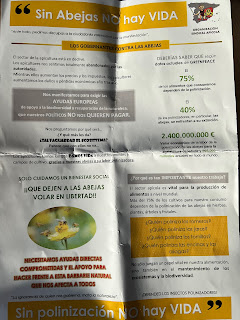Holy Grail and Beekeepers in Valencia
Every amateur student of the Grail (Last Supper Chalice) legends knows that, if one is faced with a choice of potential Grails, never choose the ornate one. The Indiana Jones films instruct us that this would be a lethal error, should one drink from it in pursuit of immortal life. Rather, the true life-giving Grail is a humble earthenware cup, suitable for a last supper in unpretentious circumstances.
What, then, is one to make of the richly splendid cup that resides in Valencia Cathedral?
This relic has been given the Papal nod as the likely True Grail, and is venerated accordingly by the faithful from far and wide. The skeptic doubts, on good Indiana Jones grounds. But the skeptic is rebutted, if not refuted, by the claim that the alleged original Grail is the simple agate cup atop the metal finery, the latter being added by church grandees in later times – as is the way with Catholic relics. Moreover, it is indeed the case that the cup was manufactured around the time of Christ. This gets us to the first stage of authentication. But the fact is that there are several other Grail candidates, and no doubt there were many contemporary drinking vessels touted as the One True Chalice.
The earliest known inventory description of the Valencia Grail dates from the 1100s. this seems like a healthy historical record, until one reflects that the 1100s are nearer to our time than to Christ’s. The skeptic and the faithful will continue to differ.
Also in the Cathedral are two paintings by Goya illustrating scenes from the life of St Francis Borgia, one the early heads of the Jesuit order. The paintings date from Goya’s “dark” period, when he was elderly, deaf and depressed, and given to themes of witches and monsters. One painting shows the saint warding off horrid demons from a dying man;
the other the saint saying farewell to tearful family and friends before taking himself off to holy orders (perhaps a painting imbued with Goya’s own isolation).
The Catholic Church is fond of martyr paintings ( there’s a number of these in the Cathedral, including one of a poor man being luridly disembowelled).
In recent times the Church, at least in Spain, has moved to honour the clergy and other faithful who fell victim to anarchist or other leftist violence in the Civil War. In the Cathedral there’s a chapel dedicated to them, with a couple of sentimental group portraits.
The chapel’s presence is ironic, or possibly deliberately chosen. Not far away is the Old Town Hall, an impressive building in one of Valencia’s magnificent car-free squares.
An Information Board reminds you that this was the seat of the Republican Government in the Civil War, until the end (Madrid was under siege for most of the War). The building’s stonework is still pitted from Nationalist bombing. Such are the stark contrasts of Spain.
Traffic may be largely but not entirely banished from the Old Centre, but it now vengefully encircles it on wide roads following the course the mostly demolished City walls.
However, even this is countered by the green park which occupies the wide corridor where a diverted river once flowed, cutting through the City. This is also the location for the remarkable edifices of the City of Arts and Sciences. An Opera House in the shape of a Roman helmet, a science museum in the guise of a huge whale skeleton, and a versatile arena in the shape of an orchid, all linked by and reflected in artificial lakes (which can be dried out to host events involving horses, athletics, or cars). Calatrava is the gloriously playful architect.
This site was created in the last 20 or 30 years. It is a strange contrast to the Old town, and especially the Cathedral, which dates back to the 13th century (Valencia being taken from the Moors during that period). But successful Spanish cities, of which Valencia is certainly one, push on.
When we had just started our walking tour, examining the Art Deco railway station, there was a slight distraction of a small demonstration forming and setting off in the nearby street. Many protesters wore what looked, at a distance, like Covid PPE – perhaps protesting medical workers, our guide suggested. She was wrong. They were bee workers, apiarists protesting against the threats to bees from modern farming. They reminded us that, without the pollinators, the circle of organic life is broken.
Feb 2023













No comments:
Post a Comment